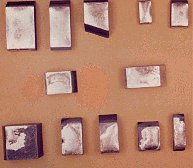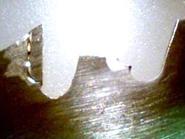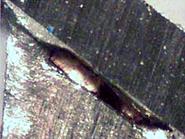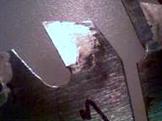Pretin
|
Pretin, Pretinning, or Tinning
Tinning, Pretinning or Pretin is applying brazing alloy to one or both parts separately then putting the parts together and heating them to complete the brazing. This allows for easier handling of the final assembly. It also ensures that the parts wet well and that brazing alloy covers all the surfaces being joined. For more articles on Pretinning and Brazing visit our Brazing Services article page.
Reducing Breakage - Pretinning can improve impact resistance. This was done with a weight drop test. A weight was dropped on the parts and a measurement was taken of the height at which the parts broke. The solder wasn’t underneath the tips or on top of the tips. We did this so the softer solder would not absorb the impact force.
This test seems to show two things. Proper use of braze alloy really increases the impact resistance of the carbide. Also proper pretinning creates much more uniform performance at a much higher level than untinned tips have. Get a Free Quote on our Brazing and Pretin Services
Quality Not all tips work well every time. (See Flow Problems below.) We have several different treatments we developed and a couple we patented (US patents 5,624,626 and 6,322,871) to make sure every tip works.
The contact angle between the braze alloy and the underlying material is a rather important means of measuring wettability and hence the success of the flow and the bond.
Bad Pretinning and Other Overheating Damages the Finished Tool
On the right is the tip behind the ripped shoulder. You can see that the braze alloy did not bond well to the carbide. The tips did not have adequate preparation and the pretinning was poorly done. You can get flow that looks good if you heat it hot enough but you seriously weaken the steel. With this kind of problem you would expect to see tip loss. It looks like the shoulders were so much weaker from overheating and embitterment of the steel that they ripped off before this tip could come out.
When you overheat the braze alloy to make it look good in Pretinning then you boil the zinc. As the alloy gets hotter it gets runnier and flows better. As the zinc boils it forces the alloy to spread out and flow. However once you have overheated the alloy in Pretinning than you have to overheat it again to braze it on the saw and this causes a heat affected zone, which in turn means brittle and ripped shoulders. To see other ways that overheating can damage the finished tool, visit our Truly Horrible Saw Blade article.
|








